 Home : Events and Festivals : Festival Home : Events and Festivals : Festival |
| |
Festivals Of Sikkim |
|
| |
Saga Dawa : Full moon day of the 4th month in the Tibetan
Lunar Calendar,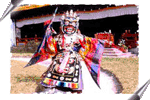 around end of May and early June. Saga Dawa is a
very important festival for the Buddhists. This day is
considered to be the holiest of the holy Buddhist Festival. On
this day Lord Buddha took birth, achieved Enlightenment and
passed away attaining Nirvana. Phang Lhabsol This festival is
held on the 15th day of the 7th month around the end of August.
This festival is unique to Sikkim. Popularized by the 3rd
Chogyal (king) of Sikkim, Chakdor Namgyal, this festival marks
the signing of the treaty of brotherhood between the Lepchas and
the Bhutias by Khye Bumsa and Tetong Tek when the local deities
and the snowy ranges of Khanchendzonga are worshiped. The lamas
portraying the guardian deity perform colorful masked dances.
Jesters called ‘Atchars ‘ lighten the mood of the spectators,
who come in hordes to witness this festival. around end of May and early June. Saga Dawa is a
very important festival for the Buddhists. This day is
considered to be the holiest of the holy Buddhist Festival. On
this day Lord Buddha took birth, achieved Enlightenment and
passed away attaining Nirvana. Phang Lhabsol This festival is
held on the 15th day of the 7th month around the end of August.
This festival is unique to Sikkim. Popularized by the 3rd
Chogyal (king) of Sikkim, Chakdor Namgyal, this festival marks
the signing of the treaty of brotherhood between the Lepchas and
the Bhutias by Khye Bumsa and Tetong Tek when the local deities
and the snowy ranges of Khanchendzonga are worshiped. The lamas
portraying the guardian deity perform colorful masked dances.
Jesters called ‘Atchars ‘ lighten the mood of the spectators,
who come in hordes to witness this festival. |
|
| |
|
|
| |
Losoong : Losoong
marks the end of the harvest season and also the end of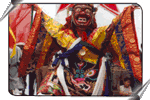 the 10th month of the Tibetan lunar year, around the end of
December. Chaam dances are performed at the Palace (Tsuklakhang ),
Phodong and Rumtek monasteries.
the 10th month of the Tibetan lunar year, around the end of
December. Chaam dances are performed at the Palace (Tsuklakhang ),
Phodong and Rumtek monasteries. |
|
| |
|
|
| |
Losar : It is the
Tibetan New year and is marked with a lot of gaiety an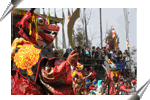 d
festivity. It falls normally in the month of February. d
festivity. It falls normally in the month of February. |
|
| |
|
|
| |
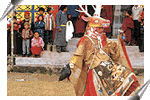 Dasain
: Also known as Durga Puja, this fortnight long Hindu festival
usually falls in the month of October. The festival symbolizes the
victory of the Hindu Goddess Durga over evil. Barley seeds are sown
in the soil on the first day of this festival and their growth
foretells good harvest. A week later is “Phulpati “ meaning the day
of flowers, followed by Maha Astami and Kala Ratri and Navami. The
10th day of the festival is known as Vijay Dashmi and also marks the
victory of Lord Rama over Ravana. During this day people smear their
foreheads with colored rice and the barley sprouts, which was sown
on the first day of Dasain, are picked and placed over the ears. Dasain
: Also known as Durga Puja, this fortnight long Hindu festival
usually falls in the month of October. The festival symbolizes the
victory of the Hindu Goddess Durga over evil. Barley seeds are sown
in the soil on the first day of this festival and their growth
foretells good harvest. A week later is “Phulpati “ meaning the day
of flowers, followed by Maha Astami and Kala Ratri and Navami. The
10th day of the festival is known as Vijay Dashmi and also marks the
victory of Lord Rama over Ravana. During this day people smear their
foreheads with colored rice and the barley sprouts, which was sown
on the first day of Dasain, are picked and placed over the ears.
|
|
| |
|
|
| |
Tihar
: Tihar is the “Festival of Light “ and symbolizes the
return of Lord Ram to his hometown from exile after victory over Ravana and covers a period of five days. The festival honors
certain animals on successive days. The first days known as a
“Kak Tihar is dedicated to crows and they are offered rice and
some if caught are even garlanded. On the second day, which is
known as “Kukkur Tihar”, dogs are garlanded. On the third day
the cows are honored with garland and their horns are painted in
bright colours. It is the turn of bullocks on the fourth day.
Deepali, which falls on the third day is considered to be the
most important day when goddess Lakshmi comes visiting every
home which is lit bright with candles and electric lights. The
fifth day is also known as Bhai Tika in which brothers visit the
home of sisters and they apply tikas vermilion to each other’s
forehead. It is also an occasion for exchanging gifts. During
Tihar, traditional carols called Bailo or Deusi are sung. to his hometown from exile after victory over Ravana and covers a period of five days. The festival honors
certain animals on successive days. The first days known as a
“Kak Tihar is dedicated to crows and they are offered rice and
some if caught are even garlanded. On the second day, which is
known as “Kukkur Tihar”, dogs are garlanded. On the third day
the cows are honored with garland and their horns are painted in
bright colours. It is the turn of bullocks on the fourth day.
Deepali, which falls on the third day is considered to be the
most important day when goddess Lakshmi comes visiting every
home which is lit bright with candles and electric lights. The
fifth day is also known as Bhai Tika in which brothers visit the
home of sisters and they apply tikas vermilion to each other’s
forehead. It is also an occasion for exchanging gifts. During
Tihar, traditional carols called Bailo or Deusi are sung.
|
|
| |
|
|
| |
Magh Sakranti : This festival
falls in the month of January and marks the lengthening of days.
Fetes are held on banks of the confluence of rivers. This is one
festival were people from all walks of life attend. |
|
| |
|
|
| |
Gutor Cham : Gutor Cham is
performed two days prior to Losar or the Tibetan New Year, this
Cham or dance depicts the battle between good and the evil and
the ritualised destruction of evil. Bhumchu at Tashiding
|
|
| |
|
|
| |
|
|
| |
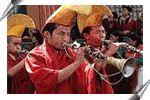 Bhumchu
at Tashiding : The Bhumchu which takes palce on the 14th
and 15th day of the first month of the Tibetan lunar
calander,around February-March ,is one of Sikkim's most
intriguing festivals. The water contained in the sacred Phumba
or vase is measured into 21 cups of equal measure. The level of
water is studied to divine the fortunes of Sikkim for the next
year. Devotees from Nepal, Bhutan and the neighbouring hills all
come for blessings Bhumchu
at Tashiding : The Bhumchu which takes palce on the 14th
and 15th day of the first month of the Tibetan lunar
calander,around February-March ,is one of Sikkim's most
intriguing festivals. The water contained in the sacred Phumba
or vase is measured into 21 cups of equal measure. The level of
water is studied to divine the fortunes of Sikkim for the next
year. Devotees from Nepal, Bhutan and the neighbouring hills all
come for blessings |
|
| |
|
|
| |
Drukpa Tseshi : This
festival celebrates Lord Buddha's first preaching of the Four Noble
Truths to his first five disciples at Saranath.. The festival is
held on the 4th day of the 6th month of the Tibetan lunar calendar.
Prayers are conducted in the main monastery. |
|
| |
|
|
| |
Tendong Lho Rum Faat :
On the8th of August, the Lepachas worship Mount Tendong which they
believe saved their race from destruction by a great flood. While
the Lepcha 'Bongthings' or priests worship Mt. Tendong in South
Sikkim, the Lepchas in Gangtok take part in day long cultural and
literary programmers in their traditional costumes |
|
| |
|
|